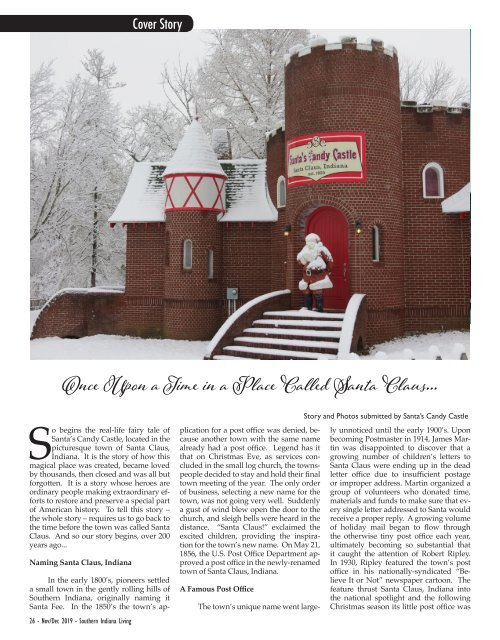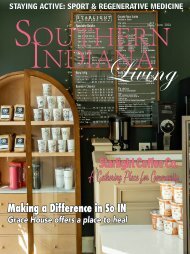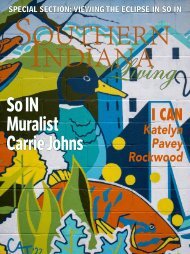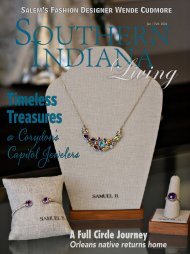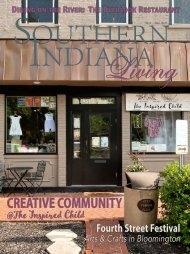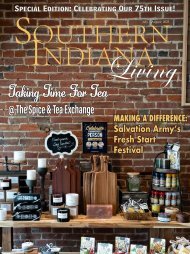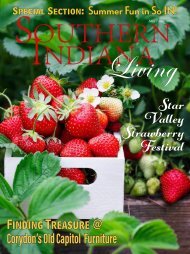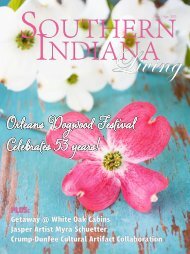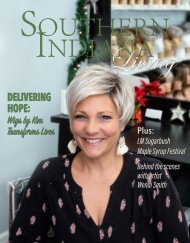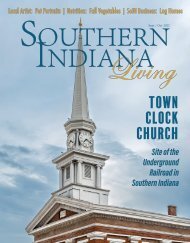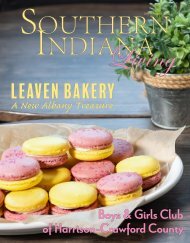SIL - Nov / Dec 2019
November / December 2019
November / December 2019
You also want an ePaper? Increase the reach of your titles
YUMPU automatically turns print PDFs into web optimized ePapers that Google loves.
Cover Story<br />
flooded with over a million pieces of mail.<br />
The town would never be the same again.<br />
Once Upon a Time in a Place Called Santa Claus...<br />
So begins the real-life fairy tale of<br />
Santa’s Candy Castle, located in the<br />
picturesque town of Santa Claus,<br />
Indiana. It is the story of how this<br />
magical place was created, became loved<br />
by thousands, then closed and was all but<br />
forgotten. It is a story whose heroes are<br />
ordinary people making extraordinary efforts<br />
to restore and preserve a special part<br />
of American history. To tell this story –<br />
the whole story – requires us to go back to<br />
the time before the town was called Santa<br />
Claus. And so our story begins, over 200<br />
years ago...<br />
Naming Santa Claus, Indiana<br />
In the early 1800’s, pioneers settled<br />
a small town in the gently rolling hills of<br />
Southern Indiana, originally naming it<br />
Santa Fee. In the 1850’s the town’s application<br />
for a post office was denied, because<br />
another town with the same name<br />
already had a post office. Legend has it<br />
that on Christmas Eve, as services concluded<br />
in the small log church, the townspeople<br />
decided to stay and hold their final<br />
town meeting of the year. The only order<br />
of business, selecting a new name for the<br />
town, was not going very well. Suddenly<br />
a gust of wind blew open the door to the<br />
church, and sleigh bells were heard in the<br />
distance. “Santa Claus!” exclaimed the<br />
excited children, providing the inspiration<br />
for the town’s new name. On May 21,<br />
1856, the U.S. Post Office Department approved<br />
a post office in the newly-renamed<br />
town of Santa Claus, Indiana.<br />
A Famous Post Office<br />
Story and Photos submitted by Santa’s Candy Castle<br />
The town’s unique name went largely<br />
unnoticed until the early 1900’s. Upon<br />
becoming Postmaster in 1914, James Martin<br />
was disappointed to discover that a<br />
growing number of children’s letters to<br />
Santa Claus were ending up in the dead<br />
letter office due to insufficient postage<br />
or improper address. Martin organized a<br />
group of volunteers who donated time,<br />
materials and funds to make sure that every<br />
single letter addressed to Santa would<br />
receive a proper reply. A growing volume<br />
of holiday mail began to flow through<br />
the otherwise tiny post office each year,<br />
ultimately becoming so substantial that<br />
it caught the attention of Robert Ripley.<br />
In 1930, Ripley featured the town’s post<br />
office in his nationally-syndicated “Believe<br />
It or Not” newspaper cartoon. The<br />
feature thrust Santa Claus, Indiana into<br />
the national spotlight and the following<br />
Christmas season its little post office was<br />
Creating Santa Claus Town<br />
Ripley’s feature not only flooded the<br />
town with more letters than ever before,<br />
visitors began to flock to the tiny town<br />
with the magical name. When they arrived,<br />
they were disappointed to find little<br />
more than the town’s post office. The town<br />
was once again faced with the prospect of<br />
disappointing children – this time face-toface.<br />
Once again, Postmaster James Martin<br />
rose to the occasion. Martin teamed<br />
with Vincennes attorney Milton Harris to<br />
create the vision for a themed attraction<br />
called “Santa Claus Town”. No one was<br />
exactly sure what these men had in mind<br />
though, since places like Knott’s Berry<br />
Farm’s Ghost Town (1940), Santa Claus<br />
Land (1946), and Walt Disney’s Disneyland<br />
(1955) were still many years away.<br />
But their vision was clear: Santa Claus<br />
Town would be a magical place where<br />
Santa would live and work year-round,<br />
and where guests could enjoy a magical<br />
Christmas morning experience every day<br />
of the year. There would be no admission<br />
charged and nothing would be for sale.<br />
Leases were secured on most of the land<br />
in the town of Santa Claus, and sponsorships<br />
were struck with major American<br />
toy and candy manufacturers.<br />
The Nation’s First Themed Attraction<br />
The first building in Santa Claus<br />
Town was Santa’s Candy Castle, a red<br />
brick building with all the elements of a<br />
real castle that looked as though it was<br />
lifted from the pages of a fairytale. It<br />
was sponsored by The Curtiss Candy<br />
Company, the creators of the Baby Ruth<br />
and Butterfinger candy bars, who were<br />
famous for their larger-than-life advertising<br />
campaigns. Santa’s Candy Castle<br />
was dedicated amidst tremendous fanfare<br />
on the cold, snowy day of <strong>Dec</strong>ember 22,<br />
1935. With broadcast television still years<br />
away, the formal dedication ceremony<br />
was broadcast live by radio station WGBF<br />
of Evansville. Thousands attended the<br />
dedication including national business<br />
leaders, politicians, and most importantly,<br />
many very excited young children. The<br />
grand affair marked the opening of Santa<br />
Claus, Indiana’s first tourist attraction and<br />
the first themed attraction in the United<br />
States.<br />
Santa’s Workshop and Toy Village<br />
Santa Claus Town expanded in 1936<br />
with the addition of Santa’s Workshop<br />
and the Toy Village. In Santa’s Workshop,<br />
children could experience the magic<br />
of watching Santa Claus make toys in a<br />
fully functional wood shop. The Toy Village<br />
featured miniature fairytale buildings<br />
sponsored by America’s leading<br />
toy manufacturers including Daisy (air<br />
rifles), Lionel (electric trains), Buddy L<br />
(steel trucks), Wyandotte (pop guns), and<br />
Strombecker (doll furniture). No admission<br />
was charged to enter these buildings<br />
and nothing was for sale. Children could<br />
simply play and have fun with all the popular<br />
toys of the day. As America struggled<br />
through the Great Depression and many<br />
families did without, the Toy Village offered<br />
thousands of children the Christmas<br />
morning they otherwise wouldn’t have<br />
had.<br />
All But Lost and Forgotten<br />
But just before Christmas in 1941,<br />
everything changed as the attack on Pearl<br />
Harbor brought America into World War<br />
II. Sponsors were lost as companies shifted<br />
from production of toys to war goods.<br />
Tourism stopped due to limited gasoline<br />
supplies and the rationing of tires. Santa<br />
Claus Town became a shadow of what it<br />
once was. After the war, Santa Claus Town<br />
creator Milton Harris began working to<br />
try to return the attraction to its original<br />
glory. Sadly however, Harris passed away<br />
unexpectedly in 1950; his dream never fully<br />
realized. Several new owners attempted<br />
to carry on variations of Harris’ vision,<br />
but the magic had been lost. In the 1970’s,<br />
Santa Claus Town closed to the public and<br />
the attraction became vacant and sat in<br />
disrepair. The magical fantasyland that<br />
had once been loved by thousands was<br />
seemingly lost and forgotten.<br />
Recapturing the Magic<br />
As the years passed, it appeared un-<br />
Chestnut Roasting Event<br />
likely that the story of Santa Claus Town<br />
would end “Happily Ever After”. But in<br />
early 2005, newspapers reported that a<br />
family had purchased the properties that<br />
comprised the original attraction, and had<br />
begun a restoration effort. The stories described<br />
an average family, whose love for<br />
history, tradition and the spirit of Christmas<br />
was anything but average. Those<br />
traveling down Candy Castle Road in<br />
Santa Claus, Indiana began to see steady<br />
progress being made on the property. A<br />
Santa sighting at the castle in late 2005 led<br />
many to believe that the magic was gradually<br />
returning to this special place.<br />
Happily Ever After<br />
In July 2006, “Happily Ever After”<br />
began to come true for Santa Claus Town.<br />
Santa’s Candy Castle re-opened its doors<br />
to the public for the first time in over three<br />
decades. A re-dedication ceremony featured<br />
speeches by those who were part<br />
of the castle’s golden age, some of whom<br />
were at the original dedication ceremony<br />
in 1935. Long-time local residents delighted<br />
in rekindled memories of a magical<br />
place once thought to be lost forever,<br />
and a whole new generation began to experience<br />
the magic for the first time, themselves.<br />
But the final chapter is far from<br />
over. Restoration continues on Santa’s<br />
Workshop and the Toy Village, offering<br />
the promise of many exciting new experiences<br />
when those properties re-open in<br />
the future. •<br />
Chestnut roasting is scheduled for Saturdays<br />
between 6-8 CST from <strong>Nov</strong>ember 30 to <strong>Dec</strong>ember<br />
21. For more information about Santa’s<br />
Candy Castle, visit website www.Santas-<br />
CandyCastle.com or find us on facebook.<br />
26 • <strong>Nov</strong>/<strong>Dec</strong> <strong>2019</strong> • Southern Indiana Living Southern Indiana Living • <strong>Nov</strong>/<strong>Dec</strong> <strong>2019</strong> • 27


